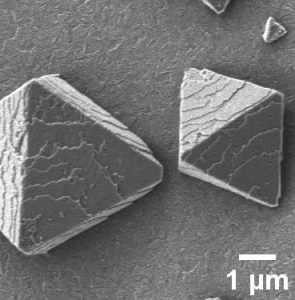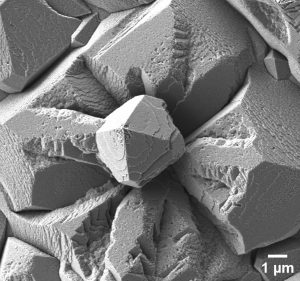Researcher(s)
- Luisa Natalia Córdoba Urresti, Chemistry, Universidad del Valle
Faculty Mentor(s)
- Rachel Davidson, Chemistry and Biochemistry, University of Delaware
- Nhat Ming Dang, Chemistry and Biochemistry, University of Delaware
Abstract
The electrochemical reduction of CO2 (CO2RR) holds the potential to transform the chemical industry by converting CO2 into valuable chemicals and fuels, while simultaneously enabling the storage of energy in chemical bonds [1].
Electrochemical reduction of CO2 (CO2RR) requires a catalyst to activate the stable CO2 molecule and direct product selectivity. Among transition metals, copper is unique in driving CO2 electroreduction towards long-chain hydrocarbons and alcohols with reasonable faradaic efficiencies (FE). However, polycrystalline Cu foil is non-selective, forming up to 16 different products [2,3]. The selectivity and activity of the catalyst strongly depend on its structure and surface composition. For example, the cubic atomic configuration of Cu(100) surfaces provides optimal adsorption geometry for CO dimers and charged intermediates, resulting in higher selectivity for CO2 reduction to ethylene. In contrast, Cu(111) and Cu(110) surfaces preferentially produce methane and ethanol, respectively [3]. Given this, it is crucial to develop synthesis methods that direct nanoparticle growth towards a specific geometry.
This work addresses the electrochemical synthesis of copper nanostructures using copper sulfate as the precursor and explores the influence of temperature and voltage on the morphological and compositional properties of the electrodeposited material. Overall, it has been observed that temperature significantly influences the morphology (Figure 1), while voltage affects the material composition.


References:
[1] Zaza, L.; Rossi, K.; Buonsanti, R. Well-Defined Copper-Based Nanocatalysts for Selective Electrochemical Reduction of CO2 to C2 Products. ACS Energy Lett. 2022, 7 (4), 1284–1291. DOI: 10.1021/acsenergylett.2c00035
[2] De Gregorio, G. L.; Burdyny, T.; Loiudice, A.; Iyengar, P.; Smith, W. A.; Buonsanti, R. Facet-Dependent Selectivity of Cu Catalysts in Electrochemical CO2 Reduction at Commercially Viable Current Densities. ACS Catal. 2020, 10 (9), 4854–4862. DOI: 10.1021/acscatal.0c00297
[3] Simon, G. H.; Kley, C. S.; Roldan Cuenya, B. Potential‐Dependent Morphology of Copper Catalysts During CO 2 Electroreduction Revealed by In Situ Atomic Force Microscopy. Angew. Chem. Int. Ed. 2020. DOI: 10.1002/anie.202010449



